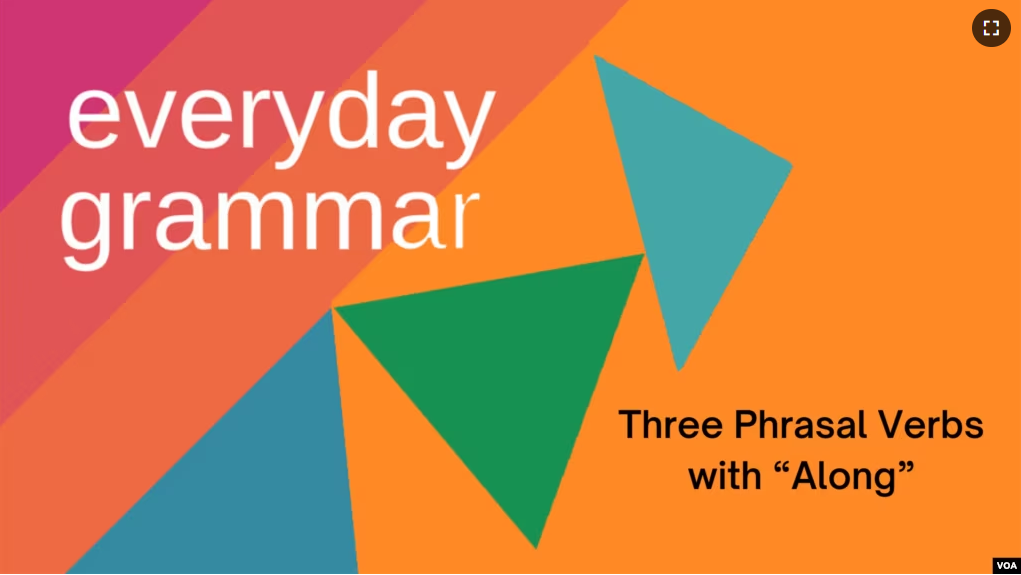Sometimes, the Learning English program Ask A Teacher receives questions from learners that we are not able to answer on that program. The question might be more advanced, and the answer longer, than we have time for on Ask A Teacher.
But the questions are worthy! So, in this week’s Everyday Grammar, we will explore Noura’s question about phrasal verbs with “along.”
Noura writes that she does not understand why we add “along” to such words as “come,” “send” and “tag.” She says that she does not see any changes to their meanings when “along” is added.
Let’s answer Noura’s question about these three phrasal verbs.
Along
“Along” as a preposition means in a line matching the length or direction of something. It can also mean points on or near something.
We drove along the coast of Maine.
We use “along” in this sentence to say that we drove on a road that runs next to, or near, the coast.
We saw beautiful beach houses along the drive.
Here we use “along” to mean points. The beach houses are the points.
Along as an adverb has many meanings. We can use “along” to describe the forward movement of something. It can also mean to be “in the company of” or “in addition to.”
When we add “along” to a verb, we get these more exact meanings.

What are phrasal verbs?
Phrasal verbs are groups of words made up of a verb and another short word or words. Together, these groups of words mean something different from what the individual words suggest. As a result, you can think of phrasal verbs as kinds of special expressions.
There are many phrasal verbs in English, and often each phrasal verb can have different meanings.
Let’s try to simplify Noura’s three phrasal verbs, “come along,” “send along” and “tag along.”
Come along
“Come along” is our first phrasal verb. It means to go with or accompany someone. Usually that person is the one who leads the way. So, the person that is “coming along” is the secondary person, who is okay with someone leading them.
Do you mind if I come along to the store with you? I just need a few things for dinner.
Come along is a phrasal verb with other meanings, too.
It can mean to make progress.
Your painting is coming along nicely. It is almost done.
And lastly, “come along” means to make an appearance.
Blue moons come along every two or three years, usually.

Send along
The next phrasal verb with “along” is “send along.” It has two meanings. The first meaning is to send something additional with something else.
My sister mailed me a gift last week and sent along a letter from my parents.
In addition to the gift, the letter was also sent.
“Send along” also means to dismiss. Usually, we can separate this phrasal verb for this meaning.
The teacher sent the children along to lunch.
Tag along
“Tag along” is like “come along.” It means to follow someone else, but with an added meaning that the person “tagging along” might not be so welcomed or is just following the other person. It has a more negative association than “come along.”
Sam’s little sister always tags along when he plays outside with his friends.
The verb “tag” by itself can mean to attach as an additional element or to follow closely. While both meanings share similarities to “tag along,” the phrasal verb has additional meaning “tagged” on.
Final thoughts
Today, we looked at three phrasal verbs with the preposition “along.” Phrasal verbs have their own separate meaning apart from the original verbs and preposition/adverb combination. “Come along” and “tag along” are similar, but “tag along” has a more negative association. You might want someone to come along with you, but tagging along, probably not. “Send along” has two meanings, to dismiss and to send something together with something else.
Thanks for the question, Noura. We hope our exploration of come, send and tag along has cleared up some of the mystery around phrasal verbs.
I’m Faith Pirlo.
And I’m Bryan Lynn.
Faith Pirlo wrote this lesson for VOA Learning English.
______________________________________________
Words in This Story
advanced – adj. having a high level of skill or difficulty
tag – v. to choose for a special purpose
matching – adj. having the qualities and looking appealing together
beach – n. an area covered with sand that is by a body of water
accompany – v. to go somewhere with someone
ingredient – n. one of the things used to make a food product
negative – adj. having harmful or undesirable effects
